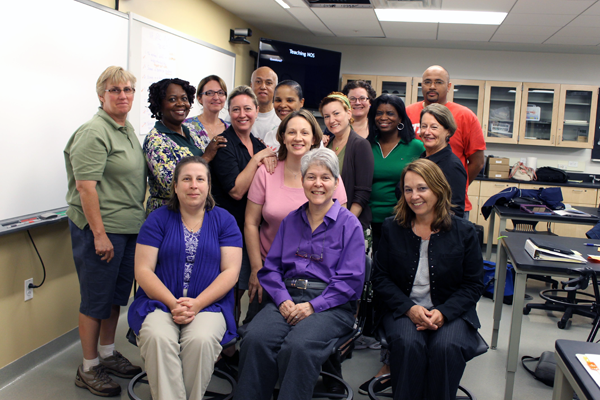Multimillion VISTA Project Creates Successful “Community of Practice” Among University Faculty
October 23, 2012
The $34 million, five-year VISTA project is transforming science education in Virginia and is also becoming a model for how to develop enduring, collaborative professional learning communities among faculty at multiple universities.
* * *
A key component of the VISTA (Virginia Initiative for Science Teaching and Achievement) project, now entering its third year, is the Science Education Faculty Academy. The academy, held on the George Mason University campus for five days each May, brings together science education faculty from as many as 10 Virginia universities.
The academy is an investment in community building and an investment in the educators who will teach the next generation of science teachers. The participants review the latest science education research, share effective teaching strategies, and build a statewide professional network among themselves. The academy participants and leaders believe the community of practice that has developed will continue to endure and spur improvements in science education for years beyond the initial grant.

The team also looks at the academy as a model that can help build bridges among university faculty in fields beyond science education. “This is a piece of VISTA that can be applied to many other fields, not just science education, and can be modified to succeed without grant support,” said Jennifer Mosser, curriculum specialist for VISTA.
The academy targets science faculty educators because typically there are very few at any given institution. “It can be a lonely job if there are no colleagues at your institution with whom you can collaborate and work together to remain at the leading edge of the field,” Mosser noted.
Faculty who participate in the academy value the sustained time to work together and figure out how to implement improvements. The collaborations are encouraged through interactive formats, such as one called “Vexation and Ventures,” which allows one person at a time to discuss a problem and potential solution. The group then confers while the initial presenter listens without speaking. Finally, the presenter has an opportunity to rejoin.
“This ‘incubator’ tool allows the group to immediately focus on their problem areas and help each other to grow,” says Mollianne Logerwell, assistant professor at Mason’s College of Education and Human Development and VISTA Director of Science Education. “The group typically continues discussions on their own throughout the evening. They are immediately able to look at each other as ‘critical peers.’ It is a very powerful way to launch a community of practice in a friendly but challenging way.”

The academy sessions also focus on science education research, provide opportunities to work on collaborative course planning, introduce state and national science organizations and policy trends, and encouage collaborative work on grant, conference, and publication planning.
Patti Horne of Averett University has attended the academy for two years. “So many connections were made,” she said. “We’ve got ongoing projects, ongoing research, we’re developing curriculum, we talk to each other regularly. It’s an instant family and these connections are just key.”
Virginia State University’s Trina Spencer agreed: “Ultimately, I’m going to be a better teacher because of this experience,” she said. “The students who are in the classroom right now are going to be better because we’re going to be better at preparing them to be excellent teachers.”
Logerwell reports that academy participants are already extending the community of practice in ways that organizers hadn’t anticipated. “Our first cohort started a private Facebook group for networking purposes and the second cohort joined right in,” she said. “Many of them have already co-presented, coauthored, and submitted group grant applications. They are presenting jointly at statewide science teacher events and bringing their students along as well. The academy has allowed them to stay together, both as personal friends and as a professional support system.”
Logerwell and Mosser suggest that modifications to the program could make it work in other environments, including splitting the five-day academy into a fall and spring session, adding distance learning options to reduce costs, and rotating the location of the event to make it easier for geographically dispersed educators to participate.
About VISTA
The Virginia Initiative for Science Teaching and Achievement (VISTA) is a statewide partnership among 60+ Virginia school districts, six Virginia universities, and the Virginia Department of Education. Its goal is to translate research-based best teaching practices into improved science teaching and student learning for all students at all levels. VISTA’s investigators are researching what elements best support teachers in helping students learn. The initiative is also working to build a community of practice among science educators across the Commonwealth. Oregon State University directs the independent evaluation of the program. VISTA is funded by a five-year, $34 million grant from the U.S. Department of Education through the Investing in Innovation (i3) program, which includes a $5.7 million private sector matching requirement.
About CEHD
George Mason University's College of Education and Human Development (CEHD) includes two schools, the Graduate School of Education, which is the largest in Virginia, and the School of Recreation, Health, and Tourism. CEHD offers a comprehensive range of degrees, courses, licensures, and professional development programs on campus, online, and on site. The college is distinguished by faculty who encourage new ways of thinking and pioneering research supported by more than $75 million in funding over the past five years.
For additional information:
- Contact CEHD Communications: cehdnews@gmu.edu
- College of Education and Human Development: cehd.gmu.edu
- VISTA: vista.gmu.edu
Follow CEHD on Facebook at www.facebook.com/MasonCEHD or Twitter at @MasonCEHD.
